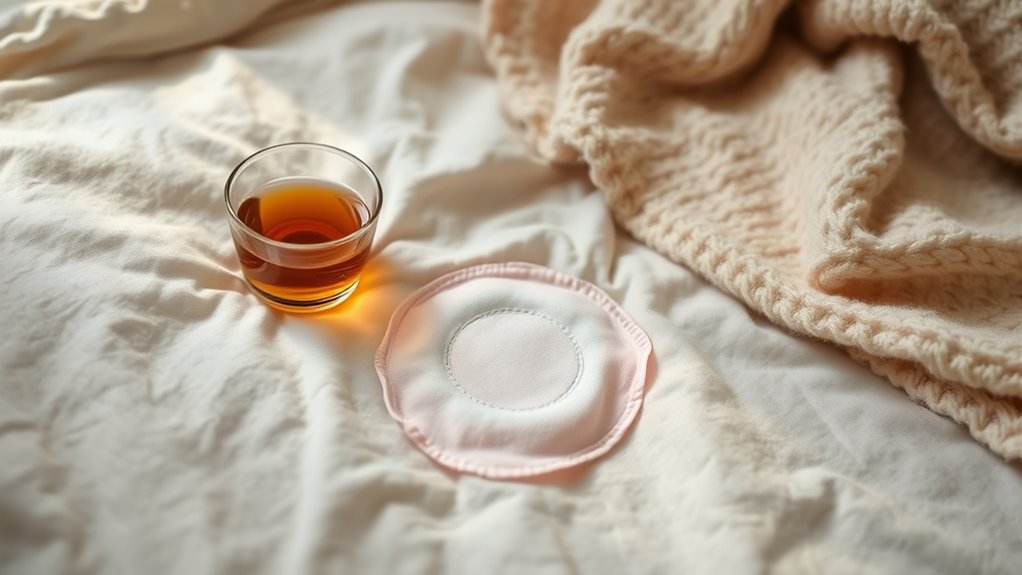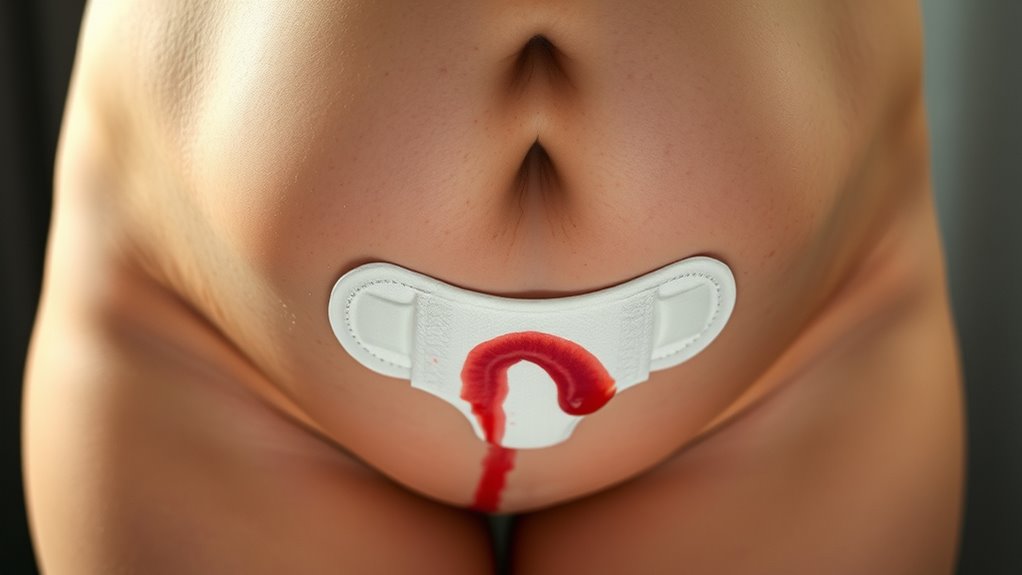Your postpartum healing involves bleeding, cramping, and recovery that varies for each woman. Lochia, or postpartum bleeding, usually lasts a few weeks, starting bright red and gradually changing color as your uterus shrinks. Cramping can last from a few days to a week, especially with breastfeeding. Keep an eye on symptoms—if bleeding soaks a pad hourly or pain worsens, see a healthcare provider. If you’d like to understand more about this healing journey, keep exploring.
Key Takeaways
- Postpartum bleeding (lochia) is bright red initially, then gradually turns pink or brown over several weeks.
- Cramping typically lasts from a few days up to one week, easing as the uterus shrinks.
- Recovery time varies, influenced by delivery type, activity level, and individual healing processes.
- Heavy bleeding, large clots, severe pain, or foul discharge indicate potential complications requiring medical attention.
- Supportive care, proper hygiene, and rest promote smoother healing and faster postpartum recovery.
Understanding Postpartum Bleeding: Lochia and Its Stages

After giving birth, your body begins a natural process of healing and recovery, which includes postpartum bleeding known as lochia. This bleeding results from the placenta separation after delivery, as your uterus contracts to expel remaining tissue and blood. Hormonal changes also drive this process, causing your uterus to shed the lining it built during pregnancy. In the early stages, lochia is usually bright red, indicating fresh blood. As healing progresses, the flow may become lighter and change in color to pink or brown. This bleeding is a normal part of postpartum recovery, signaling that your body is working to return to its pre-pregnancy state. Understanding these stages helps you recognize what’s typical during this crucial healing period. Additionally, high contrast ratios in imaging can help monitor the healing process more effectively through visual assessments. Proper postpartum care and monitoring can facilitate a smoother recovery and help detect any potential complications early.
Typical Duration of Postpartum Cramping and Discomfort

Postpartum cramping and discomfort are common, and you’ll usually notice them for a few days to a week after birth. Factors like your activity level, breastfeeding, and individual healing can influence how long they last. If cramps persist beyond a couple of weeks or become severe, it’s important to seek medical advice. Understanding the postpartum recovery process can help you better manage your healing journey. Additionally, being aware of cultural narratives about postpartum health can provide reassurance and guidance during your recovery.
Normal Duration of Cramps
Cramping is a common part of the postpartum healing process, and its duration can vary from person to person. Typically, postpartum cramps last about a few days to a week after delivery. During this time, your uterus contracts to shrink back to its normal size, which is known as the duration of uterine contractions. You may experience cramping more strongly during breastfeeding, as it stimulates the release of oxytocin, promoting postpartum cramp relief. Most women find that these cramps gradually decrease in intensity and frequency. If your cramps persist beyond two weeks or become severe, it’s a good idea to consult your healthcare provider. Remember, this period is a natural part of healing and usually resolves on its own within the expected timeframe.
Factors Influencing Discomfort
Several factors can influence how long you experience discomfort after childbirth, including individual physical differences, the type of delivery, and your overall health. Hormonal changes play a significant role, as fluctuating hormone levels can intensify cramping and emotional well-being, affecting your perception of discomfort. For example, a vaginal delivery may lead to more prolonged cramping than a cesarean, due to uterine contractions needed for healing. Additionally, your emotional well-being impacts your pain tolerance and recovery experience; stress or exhaustion can make discomfort feel more intense or last longer. Each person’s body responds uniquely, so the duration of postpartum discomfort varies. By understanding these factors, you can better anticipate and manage your postpartum recovery process.
When to Seek Help
Understanding the typical duration of postpartum cramping and discomfort can help you recognize when it’s time to seek help. If your cramping persists beyond a week or worsens, or if you experience severe pain, don’t hesitate to reach out to your healthcare provider. Emotional well-being is just as important—ongoing feelings of sadness or anxiety may signal the need for additional support. Breastfeeding challenges, such as persistent pain or latch issues, can also contribute to discomfort and should be addressed promptly. Remember, while some cramping is normal, prolonged or intense discomfort, combined with emotional distress or breastfeeding difficulties, indicates that you need professional guidance to ensure a safe and healthy recovery. Trust your instincts and seek help when something feels off. Incorporating self-care solutions such as relaxation techniques and support systems can also aid in your postpartum recovery process. Recognizing the postpartum recovery timeline can help you better understand what to expect during this healing period. Additionally, understanding the role of hormonal changes can provide insight into the physical and emotional fluctuations experienced postpartum.
The Healing Process of the Uterus and Vaginal Area

After childbirth, your uterus and vaginal area begin a rapid healing process to recover from labor. Your uterus contracts to shrink back to its pre-pregnancy size, and this process may cause cramping. The pelvic floor muscles, stretched during delivery, start to regain strength, supporting your recovery. Meanwhile, your vaginal tissue, which endured stretching and tearing, gradually heals, reducing discomfort and bleeding. Proper care, such as gentle hygiene and pelvic floor exercises, can promote healing and reduce swelling. You might notice some soreness, but overall, your body is working to restore its normal state. Healing time varies, but patience and gentle care help your uterus and vaginal area recover effectively. Incorporating vaginal tissue healing strategies can further support your recovery process, including understanding the healing stages involved. Recognizing the role of blood flow in tissue repair can also enhance your recovery.
Factors That Influence Recovery Time

Your recovery time can vary based on your medical history, so prior health issues might slow the process. Your lifestyle choices and the support system you have also play a vital role in how quickly you heal. Understanding these factors helps you better manage expectations and prioritize self-care during postpartum recovery. Being aware of narcissistic traits in your environment can also influence your emotional well-being during this period. Recognizing patterns of emotional behavior, such as trust issues, can help you address underlying relationship dynamics that may affect your mental health.
Medical History Impact
Your medical history plays a significant role in how quickly you recover postpartum. Past health conditions, surgeries, or complications can influence healing time. For example, hormonal changes after childbirth affect your body’s recovery process and emotional well-being. If you’ve experienced postpartum depression or anxiety before, it may impact your emotional resilience during recovery. Underlying health issues like thyroid problems or diabetes can slow healing or increase discomfort. Additionally, previous pregnancies and deliveries shape your recovery expectations and potential challenges. Knowing your medical history helps your healthcare provider tailor postpartum care, monitor for complications, and support your emotional well-being. Being honest about your health background guarantees you get personalized guidance, which can make your postpartum healing smoother and more comfortable. Awareness of your generative AI usage habits might also influence how you manage stress and information during recovery. Recognizing how psychological factors influence healing can help you adopt strategies to promote emotional and physical recovery. Moreover, understanding your prior health conditions enables better anticipation of possible setbacks and tailored interventions, enhancing your overall recovery experience.
Lifestyle and Support
Have you considered how your lifestyle and support system can influence your postpartum recovery? Your daily habits and emotional backing play a crucial role in healing. Prioritizing postpartum nutrition helps your body regain strength and speeds up recovery. Additionally, seeking mental health support can ease postpartum mood swings and reduce stress, promoting better healing. To optimize recovery, consider:
- Maintaining balanced, nutrient-rich meals to boost healing
- Connecting with mental health professionals or support groups
- Asking loved ones for help with daily tasks and emotional reassurance
These actions help you recover more comfortably and confidently, reducing complications and supporting overall well-being. Your choices now can positively impact your postpartum journey and long-term health.
Recognizing Normal Versus Concerning Symptoms

Understanding what symptoms are normal during postpartum recovery is essential, but it’s equally important to recognize signs that may indicate a problem. If your emotional well-being feels overwhelming or persistent sadness occurs, it could signal postpartum depression that needs attention. Normal symptoms include bleeding that gradually lightens, cramping, and manageable fatigue. However, heavy bleeding soaking a pad every hour or passing large clots may be concerning. During postpartum exercise, if you experience severe pain, dizziness, or unusual heart pounding, stop immediately and consult your healthcare provider. Keep track of your symptoms, and don’t overlook feelings of emotional distress or physical issues. Recognizing the difference between normal recovery signs and warning signals helps ensure a safer, smoother healing process.
Tips for Supporting Your Body During Recovery

Supporting your body during postpartum recovery involves prioritizing rest, proper nutrition, and gentle activity. Rest helps your body heal, while nutritious foods provide essential vitamins and minerals. Gentle postpartum exercise, like walking or stretching, can boost your mood and energy levels without overexerting. Remember, breastfeeding benefits not only your baby but also aid your recovery by releasing oxytocin, which helps your uterus contract. To support this process, consider these tips:
- Stay hydrated and eat a balanced diet rich in fruits, vegetables, and protein
- Incorporate light postpartum exercise gradually, listening to your body’s cues
- Rest whenever you can and avoid overexertion to promote healing
- Understanding breastfeeding benefits can help motivate your recovery journey.
Taking these steps helps your body recover effectively and prepares you for the days ahead.
When to Seek Medical Advice During Postpartum Healing

While following advice on rest, nutrition, and gentle activity can promote healing, it’s equally important to recognize when your recovery may require medical attention. If you experience heavy bleeding that soaks through multiple pads in an hour, severe pain, or a foul-smelling discharge, seek help promptly. Persistent cramping beyond a few weeks or difficulty with postpartum exercise due to pain or weakness could signal complications. Additionally, if breastfeeding challenges like severe nipple pain, bleeding, or signs of infection occur, consult your healthcare provider. Trust your instincts—if something feels abnormal or worsens over time, don’t hesitate to get checked. Prompt medical advice guarantees you address issues early, supporting your recovery and well-being during this essential time.
Frequently Asked Questions
How Can I Differentiate Between Normal Bleeding and Signs of Infection?
You can differentiate between normal bleeding and signs of infection by monitoring your symptoms closely. Normal bleeding will gradually decrease and stay light, while infection signs include foul odor, increased bleeding, fever, chills, or severe pain. If you notice these, seek healthcare promptly for infection signs and bleeding management. Trust your instincts—if something feels off, consult your doctor to ensure proper postpartum recovery.
Are There Specific Exercises Recommended During Postpartum Recovery?
During postpartum recovery, you should focus on gentle exercises like pelvic floor exercises and postpartum yoga. These help strengthen your core, improve bladder control, and promote healing. Start slowly and listen to your body, avoiding any movements that cause pain or discomfort. Consult your healthcare provider before beginning, especially if you had a complicated delivery. Consistent, mindful practice supports your recovery and boosts your confidence.
What Dietary Changes Support Faster Healing Postpartum?
To support faster postpartum healing, focus on eating nutrient-rich foods like fruits, vegetables, lean proteins, and whole grains. Incorporate nutritional supplements such as iron, calcium, and vitamins as recommended by your healthcare provider. Stay well-hydrated with effective hydration strategies like drinking plenty of water and herbal teas. These habits help replenish your body’s nutrients, reduce fatigue, and promote tissue repair, speeding up your recovery process.
How Does Breastfeeding Impact Postpartum Bleeding and Cramping?
Breastfeeding effects can dramatically influence your postpartum experience, acting like a hormonal symphony that speeds up healing. The hormonal influence during breastfeeding reduces bleeding by contracting your uterus and alleviates cramping through oxytocin release. This natural process not only promotes faster recovery but also helps you feel more connected with your baby. Embrace these effects, knowing that breastfeeding is a powerful tool in your postpartum healing journey.
Can Emotional Changes Affect Physical Recovery Postpartum?
Yes, emotional changes can affect your physical recovery postpartum. Hormonal fluctuations and mood swings may lead to fatigue, sleep disturbances, or even lowered immunity, which can slow healing. When you experience intense emotions, it’s harder to rest and care for yourself properly. Recognizing these feelings, seeking support, and practicing self-care help your body recover more effectively and reduce stress during this important healing period.
Conclusion
Remember, postpartum recovery varies for everyone, but understanding the typical timeline can help you feel more prepared. Most women experience bleeding and cramping for several weeks, with the uterus returning to its normal size within about six weeks. Did you know that about 80% of women report feeling fully healed by the three-month mark? Trust your body’s healing process, stay attentive to symptoms, and don’t hesitate to seek medical advice if something feels off.










